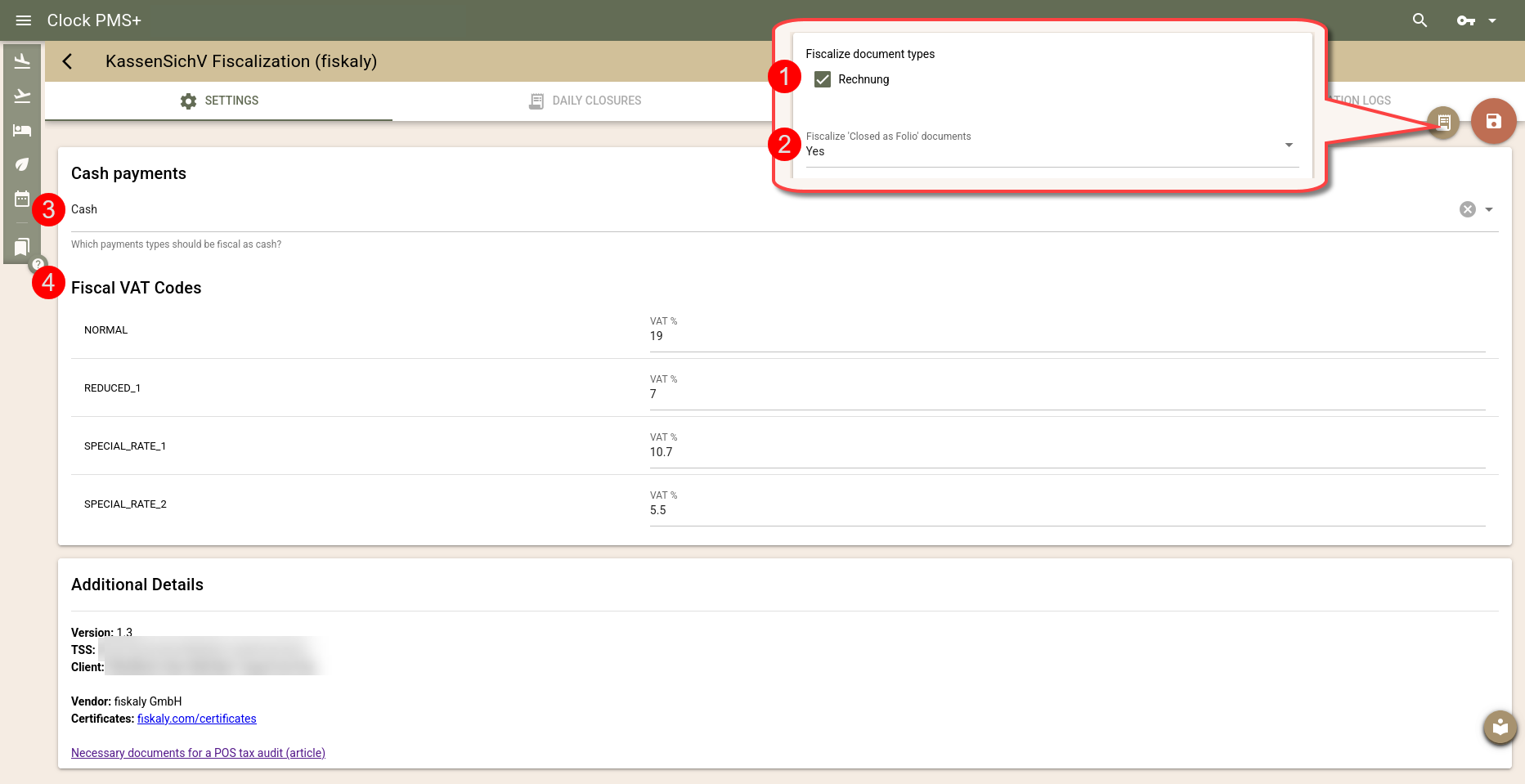Clock allows you to easily issue payment documents fiscalized in accordance with the local tax requirements of Germany. Clock is a full cloud-native solution that can be used from different input devices under one Clock account, so all of the different devices it uses under one account are treated as one cash register (one Clock account per one cash register).
How does the fiscalization process work in Clock
Fiscalization - each fully paid folio/invoice (or selected fiscal document) will be fiscalized with the closure of the folio, specifying if the payment is CASH payment. Please see below how to determine which payment types will be considered CASH. Upon the successful fiscalization, the printed folio will have a QR code, start/end time of the fiscalization, "TSE-Transaktion", "ClientID", "KassenID", "TSE-Seriennummer", "TSE-Signatur", "TSE-Zeitformat", "TSE-Hashalgorithmus", "TSE-PublicKey".
Important: At 200 EUR, the small amount limit is reached which means that the buyers address must be present on the invoice. For this purpose, the fields country, city, street, and post code must be filled out.
Important: In case of an issue with the fiscalization process, the sale DOES NOT stop. The folio is closed without fiscalization, i.e. it is not fiscalized. Therefore you need to MANUALLY restart the fiscalization process within 48 hours. To do so, simply open the folio and use the 'Fiscalize' button.
An example of successfully fiscalized folio:

For Clock POS bills/folios, this info is printed on the fiscal receipt.
Note: The Day closure is exported to Fiskaly automatically after the system's financial date change.
Settings
Activate the fiscalization through Settings -> AppConnector -> Legal -> KassenSichV Fiscalization (fiskaly). Once active, click on the Settings button to complete the fiscalization settings as part of the initial setup.

- Fiscal document types (1) - Select which document types to be fiscalised.
- Fiscalize 'Closed as Folio' documents (2) - Set if the folio documents need to be fiscalised.
- Select cash payments (3) - Select which of the provided payment methods can be considered as CASH.
- Fiscal VAT codes (4): Fill the VAT % for the different VAT codes, for example VAT code 'NORMAL' equal to 19.0 (including the decimal number, separated by point).
Daily operations
- Discounts are actually charges and payments having a negative value. For the purposes of the fiscalization process, a discount is each negative value charge in a positive folio and it will be fiscalized as such one.
- Correction folios (debit or credit) are fiscalized, if the balance of the folio to be corrected is 0, i.e. the charges are equal to the payments. If the correction folio is closed before the balance of the master folio is 0 (also including the value of the correction), the correction won't be fiscalized automatically. First, a payment is to be posted to the master folio, followed by the manual initialization of the fiscalization process. Open the folio and use the "Fiscalize" button.

- Working with advance payments (deposits)
Case 1:
Let's say that we have an advance payment to the amount of EUR 10.
1. Click on "Add deposit folio" on the booking page.
- New payment > EUR 10.
- Select the "Convert to Advance" button.

- In the next step, select a suitable charge template. Fill in the amount, adjust the print text and tax amount if necessary. Add the charge.

- After adding the necessary charges, continue with the "Next" button.

- In the next step, select the document type and finish by clicking the "Convert to Advance" button.

The deposit amount will be fiscalized.
If you use a payment operator and card payments are automatically reflected in the booking folio, consider the Advance based on available payment method.
2. Return to the booking.
- Open the folio containing the unpaid charges for which you will use the deposit.
- Press "Deduct Advance Invoice" and select the deposit folio/invoice, as well as the amount that you would like to deduct.

- The deducted amount will be reflected as a negative charge in the service folio.

3. Close the folio that is paid through the advanced payment.
- Open that folio. If necessary, add payment for the remaining amount.
- Then select the "Close folio" button and select the fiscal document.
The system will fiscalise the final amount with a plus ( + ) sign.
Case 2:
Suppose you need to refund part or all of the advance payment.
- Open the deposit folio.
- Add a negative payment for the amount to be refunded.
- Select the "Return" button;

- From the available amounts by tax groups, select the portion to be refunded, specify the credit document template, and confirm with the "Return" button.

The system will issue the credit document and fiscalise it.